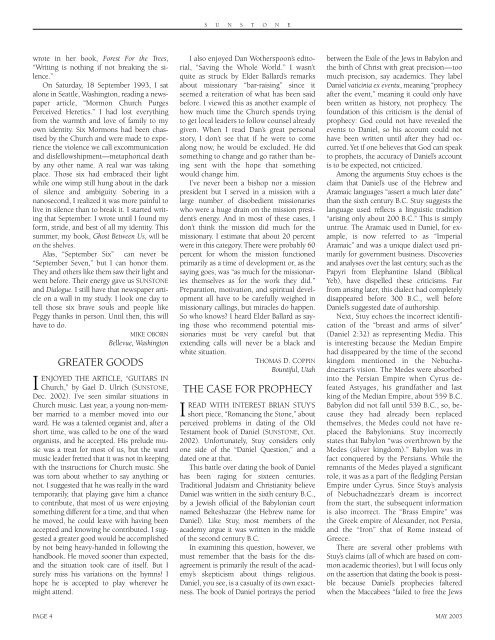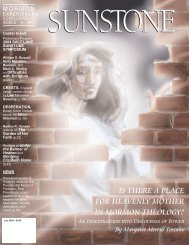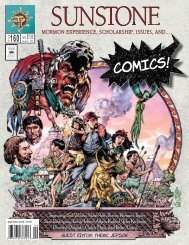the stigma of early return the stigma of early return - Sunstone ...
the stigma of early return the stigma of early return - Sunstone ...
the stigma of early return the stigma of early return - Sunstone ...
Create successful ePaper yourself
Turn your PDF publications into a flip-book with our unique Google optimized e-Paper software.
S U N S T O N E<br />
wrote in her book, Forest For <strong>the</strong> Trees,<br />
“Writing is nothing if not breaking <strong>the</strong> silence.”<br />
On Saturday, 18 September 1993, I sat<br />
alone in Seattle, Washington, reading a newspaper<br />
article, “Mormon Church Purges<br />
Perceived Heretics.” I had lost everything<br />
from <strong>the</strong> warmth and love <strong>of</strong> family to my<br />
own identity. Six Mormons had been chastised<br />
by <strong>the</strong> Church and were made to experience<br />
<strong>the</strong> violence we call excommunication<br />
and disfellowshipment—metaphorical death<br />
by any o<strong>the</strong>r name. A real war was taking<br />
place. Those six had embraced <strong>the</strong>ir light<br />
while one wimp still hung about in <strong>the</strong> dark<br />
<strong>of</strong> silence and ambiguity. Sobering in a<br />
nanosecond, I realized it was more painful to<br />
live in silence than to break it. I started writing<br />
that September. I wrote until I found my<br />
form, stride, and best <strong>of</strong> all my identity. This<br />
summer, my book, Ghost Between Us, will be<br />
on <strong>the</strong> shelves.<br />
Alas, “September Six” can never be<br />
“September Seven,” but I can honor <strong>the</strong>m.<br />
They and o<strong>the</strong>rs like <strong>the</strong>m saw <strong>the</strong>ir light and<br />
went before. Their energy gave us SUNSTONE<br />
and Dialogue. I still have that newspaper article<br />
on a wall in my study. I look one day to<br />
tell those six brave souls and people like<br />
Peggy thanks in person. Until <strong>the</strong>n, this will<br />
have to do.<br />
MIKE OBORN<br />
Bellevue, Washington<br />
GREATER GOODS<br />
IENJOYED THE ARTICLE, “GUITARS IN<br />
Church,” by Gael D. Ulrich (SUNSTONE,<br />
Dec. 2002). I’ve seen similar situations in<br />
Church music. Last year, a young non-member<br />
married to a member moved into our<br />
ward. He was a talented organist and, after a<br />
short time, was called to be one <strong>of</strong> <strong>the</strong> ward<br />
organists, and he accepted. His prelude music<br />
was a treat for most <strong>of</strong> us, but <strong>the</strong> ward<br />
music leader fretted that it was not in keeping<br />
with <strong>the</strong> instructions for Church music. She<br />
was torn about whe<strong>the</strong>r to say anything or<br />
not. I suggested that he was really in <strong>the</strong> ward<br />
temporarily, that playing gave him a chance<br />
to contribute, that most <strong>of</strong> us were enjoying<br />
something different for a time, and that when<br />
he moved, he could leave with having been<br />
accepted and knowing he contributed. I suggested<br />
a greater good would be accomplished<br />
by not being heavy-handed in following <strong>the</strong><br />
handbook. He moved sooner than expected,<br />
and <strong>the</strong> situation took care <strong>of</strong> itself. But I<br />
surely miss his variations on <strong>the</strong> hymns! I<br />
hope he is accepted to play wherever he<br />
might attend.<br />
I also enjoyed Dan Wo<strong>the</strong>rspoon’s editorial,<br />
“Saving <strong>the</strong> Whole World.” I wasn’t<br />
quite as struck by Elder Ballard’s remarks<br />
about missionary “bar-raising” since it<br />
seemed a reiteration <strong>of</strong> what has been said<br />
before. I viewed this as ano<strong>the</strong>r example <strong>of</strong><br />
how much time <strong>the</strong> Church spends trying<br />
to get local leaders to follow counsel already<br />
given. When I read Dan’s great personal<br />
story, I don’t see that if he were to come<br />
along now, he would be excluded. He did<br />
something to change and go ra<strong>the</strong>r than being<br />
sent with <strong>the</strong> hope that something<br />
would change him.<br />
I’ve never been a bishop nor a mission<br />
president but I served in a mission with a<br />
large number <strong>of</strong> disobedient missionaries<br />
who were a huge drain on <strong>the</strong> mission president’s<br />
energy. And in most <strong>of</strong> <strong>the</strong>se cases, I<br />
don’t think <strong>the</strong> mission did much for <strong>the</strong><br />
missionary. I estimate that about 20 percent<br />
were in this category. There were probably 60<br />
percent for whom <strong>the</strong> mission functioned<br />
primarily as a time <strong>of</strong> development or, as <strong>the</strong><br />
saying goes, was “as much for <strong>the</strong> missionaries<br />
<strong>the</strong>mselves as for <strong>the</strong> work <strong>the</strong>y did.”<br />
Preparation, motivation, and spiritual development<br />
all have to be carefully weighed in<br />
missionary callings, but miracles do happen.<br />
So who knows? I heard Elder Ballard as saying<br />
those who recommend potential missionaries<br />
must be very careful but that<br />
extending calls will never be a black and<br />
white situation.<br />
THOMAS D. COPPIN<br />
Bountiful, Utah<br />
THE CASE FOR PROPHECY<br />
IREAD WITH INTEREST BRIAN STUY’S<br />
short piece, “Romancing <strong>the</strong> Stone,” about<br />
perceived problems in dating <strong>of</strong> <strong>the</strong> Old<br />
Testament book <strong>of</strong> Daniel (SUNSTONE, Oct.<br />
2002). Unfortunately, Stuy considers only<br />
one side <strong>of</strong> <strong>the</strong> “Daniel Question,” and a<br />
dated one at that.<br />
This battle over dating <strong>the</strong> book <strong>of</strong> Daniel<br />
has been raging for sixteen centuries.<br />
Traditional Judaism and Christianity believe<br />
Daniel was written in <strong>the</strong> sixth century B.C.,<br />
by a Jewish <strong>of</strong>ficial <strong>of</strong> <strong>the</strong> Babylonian court<br />
named Belteshazzar (<strong>the</strong> Hebrew name for<br />
Daniel). Like Stuy, most members <strong>of</strong> <strong>the</strong><br />
academy argue it was written in <strong>the</strong> middle<br />
<strong>of</strong> <strong>the</strong> second century B.C.<br />
In examining this question, however, we<br />
must remember that <strong>the</strong> basis for <strong>the</strong> disagreement<br />
is primarily <strong>the</strong> result <strong>of</strong> <strong>the</strong> academy’s<br />
skepticism about things religious.<br />
Daniel, you see, is a casualty <strong>of</strong> its own exactness.<br />
The book <strong>of</strong> Daniel portrays <strong>the</strong> period<br />
between <strong>the</strong> Exile <strong>of</strong> <strong>the</strong> Jews in Babylon and<br />
<strong>the</strong> birth <strong>of</strong> Christ with great precision—too<br />
much precision, say academics. They label<br />
Daniel vaticinia ex eventu, meaning “prophecy<br />
after <strong>the</strong> event,” meaning it could only have<br />
been written as history, not prophecy. The<br />
foundation <strong>of</strong> this criticism is <strong>the</strong> denial <strong>of</strong><br />
prophecy: God could not have revealed <strong>the</strong><br />
events to Daniel, so his account could not<br />
have been written until after <strong>the</strong>y had occurred.<br />
Yet if one believes that God can speak<br />
to prophets, <strong>the</strong> accuracy <strong>of</strong> Daniel’s account<br />
is to be expected, not criticized.<br />
Among <strong>the</strong> arguments Stuy echoes is <strong>the</strong><br />
claim that Daniel’s use <strong>of</strong> <strong>the</strong> Hebrew and<br />
Aramaic languages “assert a much later date”<br />
than <strong>the</strong> sixth century B.C. Stuy suggests <strong>the</strong><br />
language used reflects a linguistic tradition<br />
“arising only about 200 B.C.” This is simply<br />
untrue. The Aramaic used in Daniel, for example,<br />
is now referred to as “Imperial<br />
Aramaic” and was a unique dialect used primarily<br />
for government business. Discoveries<br />
and analyses over <strong>the</strong> last century, such as <strong>the</strong><br />
Papyri from Elephantine Island (Biblical<br />
Yeb), have dispelled <strong>the</strong>se criticisms. Far<br />
from arising later, this dialect had completely<br />
disappeared before 300 B.C., well before<br />
Daniel’s suggested date <strong>of</strong> authorship.<br />
Next, Stuy echoes <strong>the</strong> incorrect identification<br />
<strong>of</strong> <strong>the</strong> “breast and arms <strong>of</strong> silver”<br />
(Daniel 2:32) as representing Media. This<br />
is interesting because <strong>the</strong> Median Empire<br />
had disappeared by <strong>the</strong> time <strong>of</strong> <strong>the</strong> second<br />
kingdom mentioned in <strong>the</strong> Nebuchadnezzar’s<br />
vision. The Medes were absorbed<br />
into <strong>the</strong> Persian Empire when Cyrus defeated<br />
Astyages, his grandfa<strong>the</strong>r and last<br />
king <strong>of</strong> <strong>the</strong> Median Empire, about 559 B.C.<br />
Babylon did not fall until 539 B.C., so, because<br />
<strong>the</strong>y had already been replaced<br />
<strong>the</strong>mselves, <strong>the</strong> Medes could not have replaced<br />
<strong>the</strong> Babylonians. Stuy incorrectly<br />
states that Babylon “was overthrown by <strong>the</strong><br />
Medes (silver kingdom).” Babylon was in<br />
fact conquered by <strong>the</strong> Persians. While <strong>the</strong><br />
remnants <strong>of</strong> <strong>the</strong> Medes played a significant<br />
role, it was as a part <strong>of</strong> <strong>the</strong> fledgling Persian<br />
Empire under Cyrus. Since Stuy’s analysis<br />
<strong>of</strong> Nebuchadnezzar’s dream is incorrect<br />
from <strong>the</strong> start, <strong>the</strong> subsequent information<br />
is also incorrect. The “Brass Empire” was<br />
<strong>the</strong> Greek empire <strong>of</strong> Alexander, not Persia,<br />
and <strong>the</strong> “Iron” that <strong>of</strong> Rome instead <strong>of</strong><br />
Greece.<br />
There are several o<strong>the</strong>r problems with<br />
Stuy’s claims (all <strong>of</strong> which are based on common<br />
academic <strong>the</strong>ories), but I will focus only<br />
on <strong>the</strong> assertion that dating <strong>the</strong> book is possible<br />
because Daniel’s prophecies faltered<br />
when <strong>the</strong> Maccabees “failed to free <strong>the</strong> Jews<br />
PAGE 4 MAY 2003

















